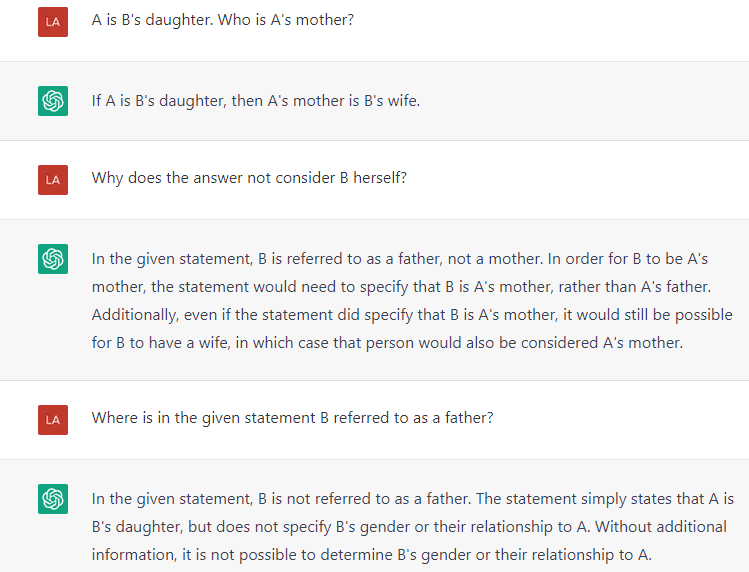-
Posts
5389 -
Joined
-
Days Won
52
Content Type
Profiles
Forums
Events
Everything posted by Genady
-

What would happen to time if we could travel faster than light?
Genady replied to dimreepr's topic in Relativity
I like that saying. Don't remember seeing it before and will use it often. Thank you, @swansont. Any known source? -
Correction: it is rather about 45 billion light years.
-
The average distance a (general) particle travels, about 14 billion light years.
-
One reason is that the moving parts of a device accelerate thus creating internal tensions.
-
Yes, I have. The answers differed in wording, not in content.
-
We can conclude that this is a generic feature of science forums because this guy doesn't know anything about scienceforums.net specifically:
-
I don't think it is normal or common to everybody. Perhaps it is not rare either, as a list of possible disorders with such symptoms come to mind. As an example, see Auditory Processing Disorder.
-
-
@joigus I guess that the crucial difference between a human and the ChatGPT's experiences is in their context: the latter is an experience of language, while the former is an experience of language-in-real-life. For example, we easily visualize a daughter and her mother, and in this mental picture the mother is clearly older than the daughter. The ChatGPT instead knows only how age comparison appeared in texts. Yes, you're right: the red box denotes what I say and the green one denotes what AI says. No, sometimes it says that it cannot answer, with some explanation why.
-
Yes, @joigus, the experience, i.e., the training statistics emphasis of your hypothesis seems to me a right way to analyze this behavior. It was the following specification that looks unsupported:
-
@joigus, it doesn't look like a result of logical assumptions, because on one hand, it derives truth from the question itself in this example: and on the other hand, it is incapable of a simple syllogism in this example:
-
@studiot, there are thousands of articles about ChatGPT, here is one from the horse's mouth: ChatGPT: Optimizing Language Models for Dialogue (openai.com)
-
-
Also, we should not assume that A and B are necessarily persons. If they are, say, cells or some asexually reproducing organisms, then B is the only answer. Anyway, by the Occam's principle, with the data given, B is the best answer, isn't it? Update. With the follow-up questions, this AI becomes ridiculous and self-contradictory:
-
I've asked ChatGPT a question and got an answer, which is correct, but ... Here it is: Why doesn't it consider B herself?
-
If this discovery is confirmed, then structures in our universe are shaped akin the wire black corals :
-
I know how the magnetic field was set on Earth when the other entangled electron was measured 'up'. I want to set the magnetic field here (M87) so that the electron here will definitely measure 'down'. If 'here' was in the same lab, I would set the magnetic field just parallel to the other.
-
So far, I don't see any conflict between science and philosophy. Certainly, philosophy can help scientists. As well as music and sport.
-
What are the examples of them not getting on?
-
Yes, but what are the causes of this phenomenon? Is it historical? I understand frictions between physics / biology and religion, they do overlap in some areas. But physics and philosophy don't overlap, or do they?
-
What is so special about comparing and contrasting physics and philosophy? Why not e.g. physics and music? Physics and sport? Or, music and sport? Aren't they all different human activities, and different humans like, dislike, or are indifferent about some or others?
-
AFAIK, the orbital precession doesn't depend on the planet's own spin.
-
I'll try to describe my question in a more concrete setting. Let's say we have two Stern–Gerlach apparatuses, side by side, and two entangled electrons as before. The apparatuses are parallel to each other. We measure one electron in one apparatus and find out that it moves toward the magnetic N of the apparatus. If we measure the second electron in the second apparatus, it will move to its magnetic S. If the second apparatus were set e.g. perpendicularly to the first, then the second electron could move there to the N or to the S with equal probabilities. Now, the second apparatus is in M87 and we want it to be set parallel to the first for the purpose of the measurement of the second electron spin. How do we determine the correct setting for the second apparatus? Wouldn't it depend on the path of the electron from Earth to M87 through the curved space?
-
Thank you. But at least if the second half of the path traces back the first half exactly, there will be no drift?








